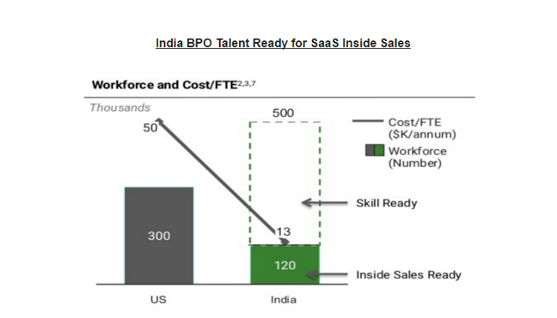With ongoing expeditious advancements in communication, social media, cloud, mobility and related technologies – sales is on a continuous path for digital transformation. This is going to place inside sales teams at a strategic position in sales and marketing process, in terms of significance. A shift is being observed from field sales model to inside sales model which is attracting field sales guys towards inside sales jobs. Therefore, the Inside Sales industry is moving towards a revolution worldwide.
Inside Sales Teams to Play a Greater Role in Sales
Inside sales is quite strategic to India’s GDP growth. Indian BPO industry alone contributes 1% of India’s GDP where professionals are majorly involved in B2C processes including inside sales. IT/ITES and software companies have been early adopters of Inside Sales process for B2B leads generation. With digital sales transformation happening for the digitally dependent buyers, the inside sales teams are going to play a greater role in sales process, as more tasks of the marketing and field sales teams have come under the scope of Inside Sales teams.
SaaS India – Early Adopters of Inside Sales Technology
SaaS, Technology and Professional Services companies in the western world are the first ones to acknowledge a digitally connected buyer by adopting Inside Sales Technology. The traditional businesses like manufacturing companies in US are exploring how Inside Sales tech may add value to their sales process.
However, in the Indian market, mainly SaaS industry is at the forefront on trying their hands on advanced Inside Sales Technology for accelerated sales. The others in the technology industry are going to follow this trend in near future in India. Traditional industries are going to take some time to change their sales processes as their buyers are slowly becoming internet savvy for business purchases.
Inside Sales to Play Significant Role in SaaS India
As per Google Accel SaaS Report 2016 – SaaS India is expected to grow to $50 billion in next 10 years while Indian SMB SaaS is expected to rise from current $600 million to $10 billion in the said period.

Source: Google Accel Report – SaaS India, Global SMB Market, $50B in 2025
SaaS industry has a strong need for inside sales professionals. As per the report, strong workforce in the BPO sector gives access to talent pool of around 6,20,000 Inside Sales professionals, out of which 1,20,000 are inside sales ready and 5,00,000 are skill ready.

Source: Google Accel Report – SaaS India, Global SMB Market, $50B in 2025
I personally believe that 6,20,000 from the BPO sector, who are assessed as ready for SaaS as per report, need to be groomed for making them sales skill ready as only telecalling skills don’t make a professional acceptable for Sales Development Rep’s role in SaaS Sales.
Inside Sales Talent – A Key Challenge for SaaS India
SDRs are expected to understand the Sales Processes. They should have the knack of using Inside Sales Tools like Social Media, Email, Phone, CRM and other smart selling tools. The working environment of B2B Inside Sales teams is significantly different from BPO scenario, where the reps are much more controlled, the jobs are temporary, the performance metrics are more around calls numbers and talk time, the customer engagements are very short lived, and end consumers are served with products & services.
This vast difference would require a complete psychological shift in the skills of a BPO professional who aspires to work in the SaaS sales space. They would need to be trained on Inside Sales function from scratch to be helpful, empathetic, B2B marketing and sales process oriented, B2B product/services domain expert, and digital sales intensive to successfully become an SDR. SDR will progress to become an account executive with quota around end closures and finally managing SDRs.
Aspirants looking to fill Inside Sales Talent Gap
There is a need to align the professionals by training for B2B Inside Sales function to serve the evolving SaaS industry in India.
I am associated with AA-ISP, American Association of Inside Sales Professionals as the President for India Chapter. The mission of AA-ISP is to advance the profession of Inside Sales. AA-ISP Gurgaon and Noida Chapter is supported by Inside Sales Box to create an ecosystem for Inside Sales professionals for businesses.
If you are a BPO/ Inside Sales/ Marketing and Sales professional or a Technology Entrepreneur, who is aspiring to stay abreast with best IS practices, discover digital sales tools & technologies, and explore jobs and business opportunities locally and globally – I welcome you to be a part of AA-ISP India.


